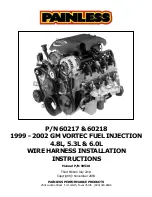
5B.17
Section 5B
EFI Fuel System
5B
8. Thoroughly clean the area around and including
the throttle body/manifold and the injectors.
9. Disconnect the throttle linkage and damper
spring from the throttle lever. Disconnect the TPS
lead from the harness.
10. Remove the manifold mounting bolts and
separate the throttle body/manifold from the
engine leaving the TPS, fuel rail, air baffle,
injectors and line connections intact. Discard the
old gaskets.
11. Position the manifold assembly over an
appropriate container and turn the key switch
“on”
to activate the fuel pump and pressurize the
system. Do not turn switch to
“start”
position.
12. If either injector exhibits leakage of more than
two to four drops per minute from the tip, or
shows any sign of leakage around the outer shell,
turn the ignition switch off and replace injector as
follows.
13. Depressurize the fuel system following the
procedure in the fuel warning on page 5B.2.
Remove the two fuel rail mounting screws.
14. Clean any dirt accumulation from the sealing/
mounting area of the faulty injector(s) and
disconnect the electrical connector(s).
15. Pull the retaining clip off the top of the injector(s)
and remove from manifold.
16. Reverse the appropriate procedures to install the
new injector(s) and reassemble the engine. Use
new O-Rings any time an injector is removed
(new replacement injectors include new O-Rings).
Lubricate O-Rings lightly with oil. Torque the fuel
rail and blower housing mounting screws to
3.9 N·m (35 in. lb.)
, and the intake manifold and
air cleaner mounting screws to
9.9 N·m
(88 in. lb.)
.
Injector problems due to dirt or clogging are generally
unlikely, due to the design of the injectors, the high
fuel pressure, and the detergent additives in the
gasoline. Symptoms that could be caused by dirty/
clogged injectors include rough idle, hesitation/
stumble during acceleration, or triggering of fault
codes related to fuel delivery. Injector clogging is
usually caused by a buildup of deposits on the
director plate, restricting the flow of fuel, resulting in
a poor spray pattern. Some contributing factors to
injector clogging include higher than normal
operating temperatures, short operating intervals, and
dirty, incorrect, or poor quality fuel. Cleaning of
clogged injectors is not recommended; they should be
replaced. Additives and higher grades of fuel can be
used as a preventative measure if clogging has been a
problem.
Ignition System
General
A high voltage, solid state, battery ignition system is
used with the EFI system. The ECU controls the
ignition output and timing through transistorized
control of the primary current delivered to the coils.
Based on input from the speed sensor, the ECU
determines the correct firing point for the speed at
which the engine is running. At the proper instant, it
releases the flow of primary current to the coil. The
primary current induces high voltage in the coil
secondary, which is then delivered to the spark plug.
Each coil fires every revolution, but every other spark
is “wasted.”
Service
Except for removing the spark plug lead by
unscrewing it from the secondary tower (see Figure
5B-22), no coil servicing is possible. If a coil is
determined to be faulty, replacement is necessary. An
ohmmeter may be used to test the wiring and coil
windings.
Figure 5B-22. Ignition Coil.
NOTE: Do not ground the coils with the ignition
‘‘on,’’
as they may overheat or spark.
Testing
1. Disconnect the main harness connector from ECU.
“35 Pin” (MA 1.7) Metal-Cased ECU:
Locate pins
#1 and #19 in the 35 pin connector. See page 5B.28.
Содержание COMMAND CH18
Страница 1: ...SERVICE MANUAL HORIZONTAL CRANKSHAFT COMMAND CH18 750...
Страница 98: ......
Страница 99: ......
Страница 102: ......
















































